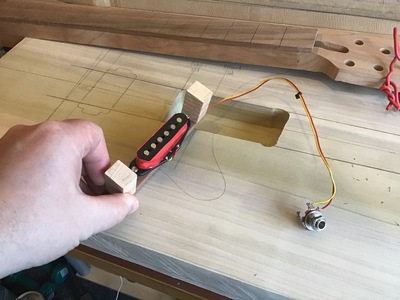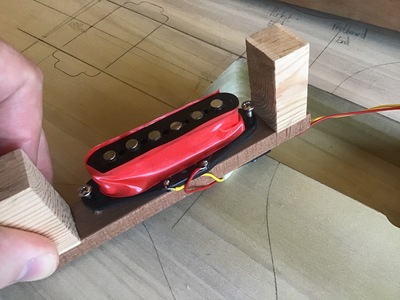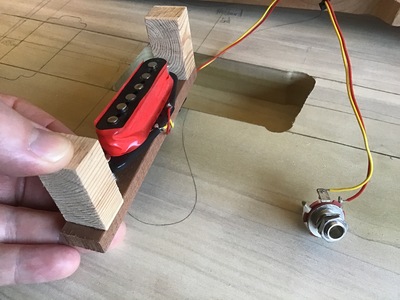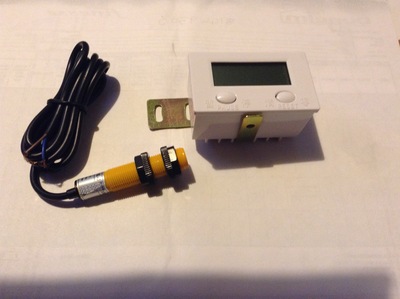I just know that someone will get their rocks off on this one! I saw a video of his first prototype and this has come quite along way since then.
I kind of like the idea of being able to make pick ups but I think that is just the manufacturing control freak in me! Any members already engaged in this black art?
Any members already engaged in this black art?
@darrenking It’s funny you should ask that. 😁
Im having a dabble, yes. A friend of mine and I have been looking into pickup winding and we are testing them. This picture shows a home-wound single coil on a wooden setting chassis.
Make guitars, not war 🌍✌️🎸
Its something I've thought about for a while (years) and have discussed it a length with a friend of mine who has a degree in instrumentation and is also an instrument builder. Never actually tried it yet as I'm too busy with wood stuff.
Obviously you have to know the capacitance per metre of the wire and count the number of turns to get the final impedance of the pick up. I've also read that it matters which end of the winding is positive or negative. From memory I think the negative, or ground, should be at the start of the winding.
An amplifier input impedance should be about three times that of the pick up or device, so that's a starting point - one third of your amp input. However there's a drawback to self building electronic stuff, experts have already worked it all out using sophisticated equipment so unless you need something that's not commercially available it's a bit pointless trying to build something better.
Magnets also have a damping effect on the string vibrations so using a more powerful magnet doesn't translate into more power output or a better sound. An active tone control to amplify close to the sound source and improve the signal to noise ratio is worth looking at. Most guitars have an unbalanced output but if you want low noise quality then humbucker is the way to go.
Apologies if you know all this already.
Attached is a pic of a magnetic counter I bought on eBay (£12) planning to use my metal work lathe with electronics speed control to do the winding. The counter is
powered by 12v supply but no wiring instructions.
Some people call me a tool, others are less complimentary. Tools being useful things.
I built a pickup winder a while back - I wound a a P90 but as yet haven’t tested it.......
Why haven’t I tested it?
Simple - nothing to test it in!
I have started work on a pickup test guitar - I have a Strat body and a Tele neck - I have butchered the body to allow pickups to be slid in without having to remove the strings.
The winder works - uses the same counter as Rocknroller912 and a sewing machine motor.
Will try make some progress after Christmas.
Measure once........ Measure again......... Sod it - make tea!
Could you help me out with how you wired your counter up please, which connections are the power supply. Don't want to do trial and error in case I damage it.
Some people call me a tool, others are less complimentary. Tools being useful things.
The probe is connected to the count connections - the counter is battery powered. You need to test the best distance for the magnet.
Also it will only count lowish speeds - I found that as I turned up the speed eventually it stopped counting......
Measure once........ Measure again......... Sod it - make tea!
However there's a drawback to self building electronic stuff, experts have already worked it all out using sophisticated equipment so unless you need something that's not commercially available it's a bit pointless trying to build something better.
That pretty much sums it up for me. As much as I love electric guitars I have never had the urge to make my own pickups. Much respect to those who do though. There is something attractive about it of course, but I’m much more into the woodwork. I also don’t want to make the bridge or truss rod....
Practice on scrap...
However there's a drawback to self building electronic stuff, experts have already worked it all out using sophisticated equipment so unless you need something that's not commercially available it's a bit pointless trying to build something better.
Hi Rocknroller,
I think you may be missing the point. The ‘experts’ you mention are also constrained by budgets that means that whatever pick up they design has to be manufactured for about 10% of what you pay for it in the shops. The same logic could be applied to making our own guitars. Just because there are big companies out there making mass produced instruments doesn’t mean that we can’t build something equally as good, if not better, ourselves. A pick up might not be as sexy as a whole guitar but I think there would be a real extra level of satisfaction in having made it yourself. It’s not an easy next step, and certainly not for everyone, but I can really understand the desire to have a go and experiment. The beauty of this forum is the ability to tap into, and share, other members’ interests (obsessions!) and learn from them, as, collectively we can try out far more ideas than we could individually.
Merry Christmas one and all and here’s to a new year ahead!
Darren
A pick up might not be as sexy as a whole guitar but I think there would be a real extra level of satisfaction in having made it yourself.
Amen. It’s difficult to keep up, but the recent thinking was that the random windings of a manually wired pickup were always superior to a factory/computer generated coil.
I won’t raise the Chinese Elephant in the room...
Jack of all trades and master of my own destiny. It’s only a small destiny.
That’s one of the selling points from say, Bare Knuckle pickups. Scatter wound pickups have their own unique quality, apparently.
Practice on scrap...
I can understand why people would want to do a self build pick up but it should be different to an off the shelf commercial product to make it worthwhile. It's important to start with a definite idea of the frequency range required and the application it's going to be used in e.g. live performance or studio recording/home playing as one will have a higher output with more windings and the other will have a lower output with fewer windings.
I don't have the calculations for capacitative reactance and frequency to hand so if anyone does it would be useful to see them as a starting point.
Interesting home build project: In theory it's possible to wire a single coil for balanced line output by making the case from metal and connecting to ground with the two ends of the winding being signal connections to a stereo jack socket. This would have the same noise cancelling effect as a humbucker and would probably only work with a mixing desk that had an input level control to avoid input clipping, however it would give a cleaner sound and signals are often boosted over long cable runs to avoid loss and then reduced at the output end.
Some people call me a tool, others are less complimentary. Tools being useful things.
As far as I know scatter winding produces a higher resonant frequency which gives a fuller range of sound
Some people call me a tool, others are less complimentary. Tools being useful things.
Hi Rocknroller,
That sounds an awful lot more complicated than most of the ‘winding your own pick-ups’ videos I’ve watched on YouTube. They mainly seem to be concerned with the the pattern of winding and the overall resistance of the winding, which is directly related to the length of wire wound. When you buy copper wire you will be able to specify the gauge and see the stated resistance per meter for any given product but that is about it. None of the videos that I have seen mention calculating capacitative reactance and frequency or ask you to decide whether you are going to be using the guitar for live playing or studio recording and I can’t remember ever seeing a guitar for sale that stated it was suitable for one use but not the other. I’m pretty sure lots of very highly regarded professional musicians use at least some of the same instruments on stage and at home as they do in the studio. The point I was making was that I’m not making guitars because I don’t think that there are any commercially available guitars that suit my needs, I just want to make my own guitar whether it ends up inferior, superior or indistinguishable from any other, I don’t care, I’ve made it myself. The same would apply if I end up making my own pick ups, and worrying that it would end up costing more than an off-the-shelf product or that I would not end up with something that represented a revolution, or even a step forward, in pick-up design, really wouldn’t put me off from having a go. The ultimate example of the motivation that drives me to make things is this http://www.thomasthwaites.com/the-toaster-project/ Why spend so much time, money and effort to make a crap version of something that you can buy in Argos for less than £10? The answer is completely illogical, but very simple, why not? There is much knowledge to be gained in the trying.
Cheers
Darren
Can't disagree with you it's not an absolute requirement to do complicated calculations but anyone who works to a high standard as you obviously do will start with something basic and want to improve it to a higher standard, which I totally understand. Bass and 6 string pick ups work by being tuned to different frequency ranges so it's necessary to be in the correct ball park. A bass pick up will sound a guitar top E but not very well.
Videos will only mention the basic process and not go into theory as most people would switch off. Commercial products are as you said about production cost/profit and are often are a compromise to cover all applications so you probably wouldn't find a pick up designed specifically for studio or live use. But it does happen for microphones.
More windings will give a higher output but also amplify the noise which wouldn't be noticed in a rock concert but would show when playing low volumes at home so it's possible to design one for an application.
Some people call me a tool, others are less complimentary. Tools being useful things.
My thoughts on pickup winding are that I can just try some of the variables and see what they sound like - vary number of winds, wire thickness and material, magnet type and strength, coil taps (as opposed to splits), covers against no covers.
Also to look at active electronics.......
For the cost of a decent pair of pickups I have a winder and enough components to build 10 pickups - if one doesn’t work then bin the wire and build another one...
Measure once........ Measure again......... Sod it - make tea!
Sounds like good fun. It will be interesting if you record the results as you go along with different wire types, capacitance, impedance and sound quality. Like a proper science experiment then we can all crib your hard work !
Some people call me a tool, others are less complimentary. Tools being useful things.
From a bit of research a while back the effective capacitance of pickups is quite small compared to that of typical guitar cables. Resonant peaks of guitar pickups tend to be at ultrasonic frequencies. Tone controls probably have a greater effect on the tonal balance - another thing to play with.
Another avenue to explore is series and or parallel connection of coils within pickups and between pickups - my Bailey Workshop course Tele has a 4 position switch giving the usual three positions (bridge, both in parallel and neck) plus both connected in series - the series position is louder and fuller than the parallel one.
Measure once........ Measure again......... Sod it - make tea!






